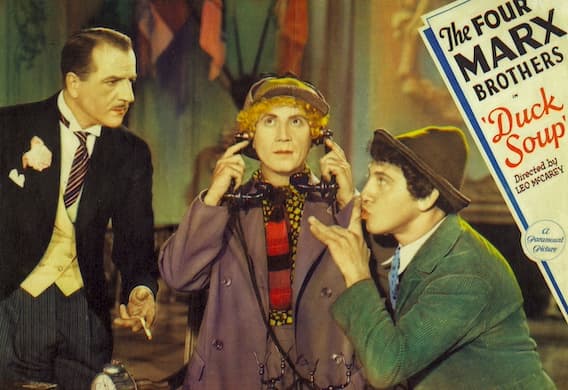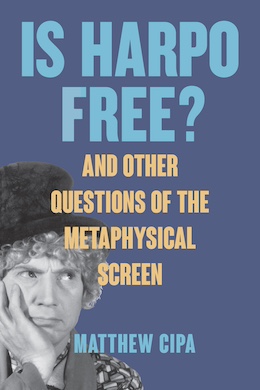Allow Harpo Marx To Guide You Into an Appreciation of the Philosophical Side of Film and Television
When author Matthew Cipa isn’t teaching in Australia, it seems, he is always hunkered in front of the television or at the local cinema thinking about the means and meaning of popular entertainment.

‘Is Harpo Free? And Other Questions of the Metaphysical Screen’
By Matthew Cipa
State University of New York Press
Tell the truth: Wouldn’t you be more inclined to read a book on metaphysics if Harpo Marx was on the cover? There are those who might pick up the stray tome on causality and free will independent of the cover design, but an image of the most anarchic of the Marx Brothers would seem to herald a less highfalutin approach to a heady subject.
Potential readers would, of course, have to recognize the silent Marx. A Gen Zer of acquaintance, espying my copy of “Is Harpo Free? And Other Questions of the Metaphysical Screen,” asked why the author’s photo was on the front of the book. As it is, Matthew Cipa’s face is nowhere to be seen amongst the pages of this “appreciation of film and television’s ability to artistically explore concepts typical of philosophical metaphysics.”
Mr. Cipa teaches at two schools in Australia: Queensland University of Technology and the School of Languages and Cultures at the University of Queensland. The rest of the time he is, it seems, hunkered in front of the television or at the local cinema thinking about the means and meaning of popular entertainment. Mr. Cipa doesn’t mess around: he takes his syuzhet and fabula seriously.
Yeah, I had to look them up. “Syuzhet” and “fabula” are terms stemming from Russian Formalism, a literary school of thought that put a stringent spin on l’art pour l’art. “Syuzhet” is, if I understand it correctly, congruent to the plot of a given film, and “fabula” its theme. “There is,” Mr. Cipa writes, “a superabundance of terminology … when looking to categorize the variety of complex narratives across film and television.”

He’s not kidding. A number of philosophically inclined folks have, apparently, made it their stock-in-trade to glean metaphysical currents within this-or-that picture or TV show. With the exception of the novelist Iris Murdoch, most of these authors are likely unknown to general readers. Suffice it to say that anyone picking up “Is Harpo Free?” had better be conversant with terms like “qualia” and issues pertaining to “the fatalism of spatial convergence.”
Which isn’t to say that Mr. Cipa’s book doesn’t underline and amplify tenets of filmmaking. Like many philosophical texts, circuitous language is employed to uncover obvious truths that may, in the end, not be all that obvious or, more likely, are taken for granted. Take as an example, the author insisting that quality is best achieved through the thorough integration of form and content.
Sounds shopworn, don’t you think? Still, it’s an argument worth iterating in a cultural landscape that often privileges theory over craft. Although Mr. Cipa deals with classy movies — “A History of Violence” (2005) no less than “Three Colours: Blue” (1993) — he does bring outliers into the discussion, not least the last movie written and directed by Jerry Lewis, “Cracking Up” (1983). The author writes that the film “opens up the possibilities of what can be included creatively, comedically, and cinematically.” He’s persuasive enough to prompt thoughts of rewatching what is, in memory, a disastrous entertainment.
Mr. Cipa is at his best when writing about Westerns. In a chapter titled “Is Shane Virtuous?” he links the Aristotelian notion of telos — that is to say, the culmination of a particular purpose — with virtue. Mr. Cipa points up the sharp moral ambiguities put into place by “High Noon” (1952), “3:10 to Yuma” (1957), and “The Man Who Shot Liberty Valance” (1962) and underscores the pivotal role of violence in Westerns. “The genre articulates the richness of human experience, and the struggle to find one’s footing in the world.” That sounds about right.
The concluding chapter, “What Can Film and Television Do?,” is also good, wherein Mr. Cipa writes about mimesis and wonder. He ropes in “Harvey” (1950), “The Secret Life of Walter Mitty” (1947), and “Paterson” (2016) as examples of how art can provide aesthetic and spiritual sustenance. Jim Jarmusch’s use of montage in the latter film is cited as being pivotal in shouldering the responsibilities of metaphor in a “remaking of the world of ordinary experience.”
As for the title query: Mr. Cipa, ever philosophical, is wary of providing a definite answer. Harpo, that “transcendent being” and “joyous force of chaos,” is brandished as but one conduit to “an expanded sense of art and the world to which it is tied.” Lofty stuff for a vaudevillian specializing in priapic horseplay, don’t you think? Mr. Cipa is good to remind us how important questions can stem from the unlikeliest of sources.

